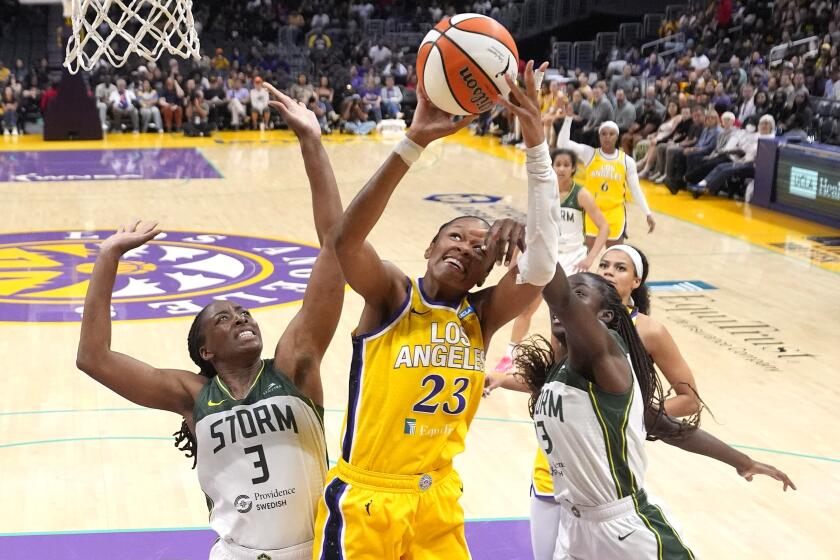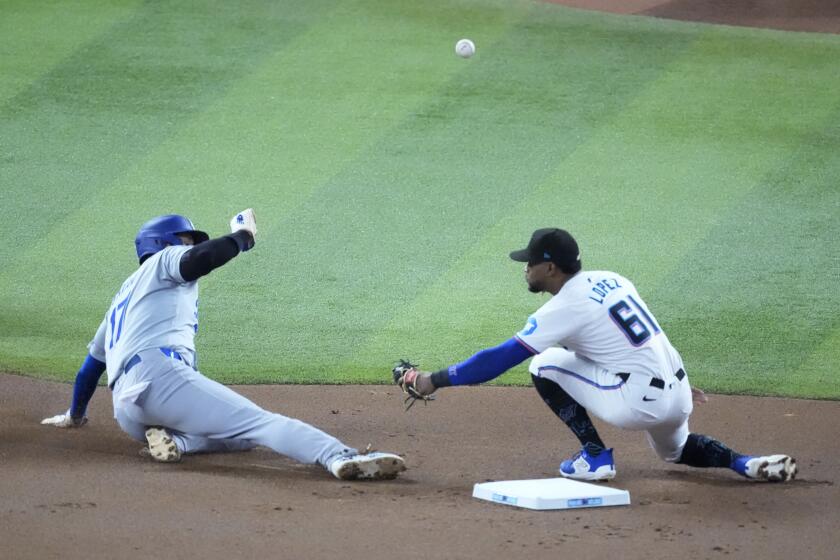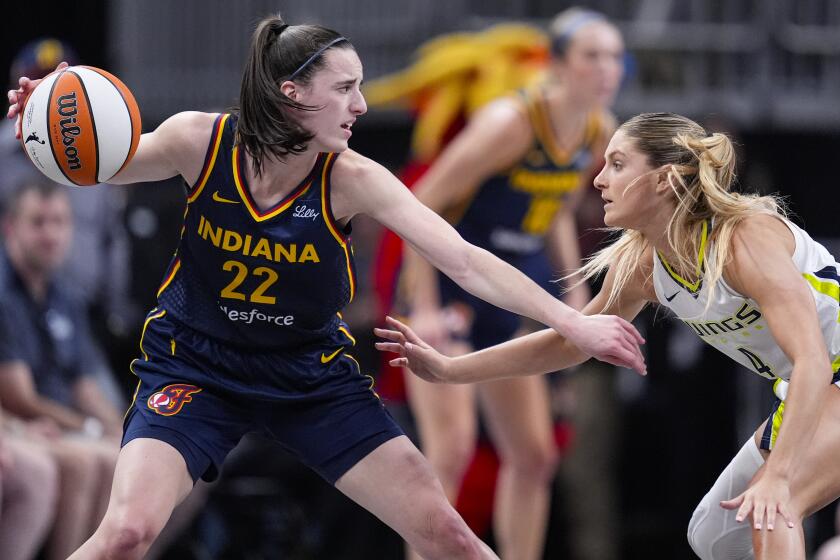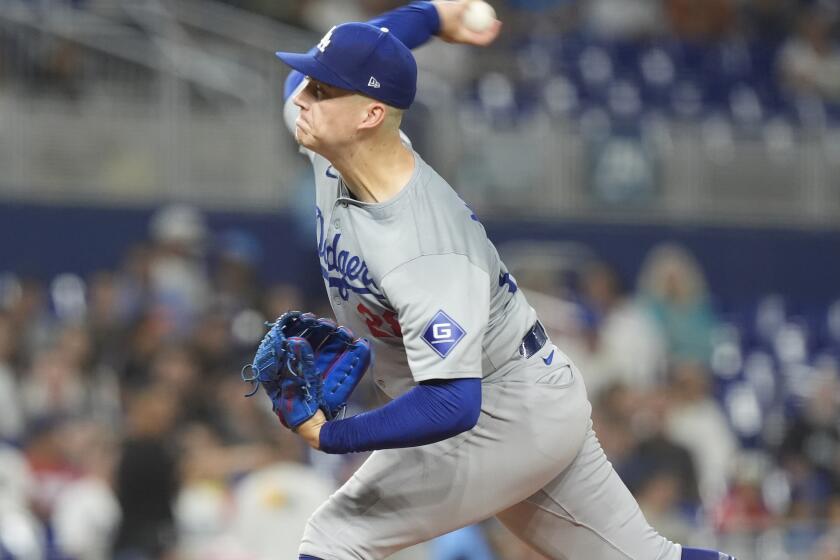Jets Pass a Test
Chad Pennington, the New York Jets’ hard-throwing young quarterback, tightened up the steamy Tennessee-Indianapolis divisional race Monday night when he completed all eight of his second-half passes to topple Tennessee, 24-17.
Pennington’s aggressive first-down passing won it only because, with the game on the line, Tory Tennessee Coach Jeff Fisher kept trying to run the ball with over-the-hill tailback Eddie George.
Not until the Jets had an impregnable 14-point lead did Fisher let his superb passer, Steve McNair, open up.
At that late hour, McNair, the NFL’s MVP heir-apparent who had begun the scoring in the game’s first minutes with a 59-yard touchdown bomb, showed what else he could have done if Fisher had taken the rest of the night off. First, McNair, with 12 consecutive pass plays, moved the Titans 73 yards to the Jet three-yard line, where he lost the touchdown only when Fisher sent George back in to buck the ball over, which he couldn’t do.
Then McNair, restricted by an injured leg that kept him from the scrambling that makes him really dangerous, drove Tennessee 50 yards on seven consecutive pass plays to the touchdown that wasn’t enough when an onside kickoff failed. And so, going into the NFL’s Game of Week 14 at Nashville next Sunday, Tennessee and Indianapolis are locked at 9-3.
More Turnovers and Triumphs
A DAY EARLIER, Indianapolis had also lost the same way: by running the ball too much instead of calling on passer Peyton Manning. The New England Patriots won that one at Indianapolis on quarterback Tom Brady’s aggressive passing, 38-34, in a game demonstrating that they and the St. Louis Rams share three traits in common this season.
The Patriots and Rams both throw critical interceptions, both keep throwing the ball anyway, and both usually win.
So look for both to ignore turnovers and win again next Sunday — the Patriots over Miami in the AFC East’s Game of the Week and the Rams over Cleveland next Monday night. For, at both St. Louis and New England, head coaches Mike Martz and Bill Belichick understand that turnovers are overrated. Consider:
Last Sunday when Minnesota caught up with the Rams in the second quarter, 17-17 — after Ram quarterback Marc Bulger’s fifth interception in his most recent six quarters of football — the Ram pass offense sailed along anyway, completing 16 of 21 for 255 yards and an easy 48-17 triumph.
On that afternoon at Indianapolis, a 21-point Patriot lead disappeared in the fourth quarter in a flurry of three turnovers as the Colts caught up, 31-31, on Manning’s three touchdown passes. In the last eight minutes, though, the Colts reverted to their running-play style as Manning kept handing off while Patriot quarterback Brady, disregarding the possibility of more turnovers, kept throwing to win by four points.
Play Selection Proves Decisive
THE PLAY-CALLING was the whole difference in those final minutes at Indianapolis, ending a struggle that had segued into one of the most competitive and dramatic games of a competitive, dramatic NFL season. These are the series of plays that decided the game:
With 10:10 remaining, the score tied at 31 and a first down at the Indianapolis 31-yard line, the Patriots called passes on every play, four in a row, and completed three of them — the last a 13-yarder from Brady to 5-foot-9 wide receiver Deion Branch (on a fake draw) for the winning touchdown.
Down 38-34, the Colts, with 40 seconds left and a first down at the New England two-yard line, began with two Edgerrin James runs and followed with a poorly designed and executed third-down pass play. Then they ended the series with another James run to nowhere, meaning the Colts messed up all four plays.
Willie McGinest, who lined up as the Patriots’ left outside linebacker, deservedly got the credit for the winning defensive play on James’ fourth-down run. Sneaking along the line of scrimmage, former USC Trojan McGinest came in from far outside on his bad leg, and, timing his charge exquisitely, stuffed James before the great Colt back could get moving.
The Patriots’ four-play defensive sequence on the Colts’ final series is likely to be remembered in Indianapolis until the end of time as a historic goal-line stand, though it wasn’t that. Rather, in light of the Colts’ conservative calls, it was a remarkable goal-line folly. It’s impossible to believe that Manning would have thrown nothing but incompletes if the Colts had come up to first and goal at the two-yard line intending to throw on all four downs — or, alternatively, to throw twice, run once, and throw again on fourth down. Their great weapon is Manning’s arm, not James’ power.
Colts’ Coaches Beat Themselves
EARLIER, WHEN THE Patriots kept throwing the ball with a seemingly secure 31-10 lead as the second half ticked away at Indianapolis, every conservative asked the same questions: Why take that chance? Why don’t they run?
The answer is that their opponents were the high-powered Colts, who, with the better players, would have 1) wiped out any Patriot lead and 2) won the game easily any time they quit trying to win with running back James.
The Colt passer, Manning, is as good as any the NFL has seen in many years. His leaders, however, are deeply conservative, both of them — Coach Tony Dungy and offensive coordinator Tom Moore. They’ve both convinced themselves that beyond all doubt, reasonable or otherwise, football teams must run to set up passes.
And in James, they do have a splendid runner. But this is a passing era. And the nation’s best teams, college or pro, don’t wait for the comparatively slow-moving ground-play offense to set up anything. Instead, they throw even on first down.
In effect, Dungy and Moore have been crippling their own offense and beating their own guy, Manning — as Tennessee’s coach Fisher did to McNair Monday night.
Schemes Do Make the Difference
FOOTBALL’S CONSERVATIVES contend, above all, that schemes don’t win football games, that players do. By schemes they mean strategic plans. A scheme can be a ball-control running-play approach in order to “take time off the clock” and keep the opposing passer off the field. Or it can be, among many other possible approaches, a pass-play plan.
The Colt-Patriot game Sunday was a classic example of scheme against scheme. It wasn’t player against player — it wasn’t Brady vs. Manning. It was an example of how a team like the Patriots, with the better scheme, outscores a team with the better players. The contrast:
In the Colts’ offensive scheme under their present coaches, they are telegraphing most of their plays. On early downs, they line up in power formations and run the ball with James. On third-down plays, and sometimes on second and long, they line up in a shotgun formation and pass. So defensive teams meet James with eight-man lines on first down and then shift into pass defenses when on third down Manning becomes a shotgun passer. It’s a measure of the excellence of the Colts’ personnel that they’re 9-3 with this goofy scheme.
In the Patriots’ scheme, when they line up in running-play formations, they pass as often as they run, particularly on first down. And when they line up to pass, they often run — as they did successfully Sunday on third and three, a traditional passing down. By comparison with Indianapolis, which usually gives James a lead blocker (often the fullback) who thus gives away the play, New England typically benches its fullback. Instead, it deploys an extra receiver, either a second tight end or a third receiver or a running back up on the line as a fourth or fifth receiver.
Against these formations, the Colt defense had to contend, of course, with a Patriot running-play threat Sunday, but it was usually battered with the pass as Brady completed 26 of 35.
How Manning Differs from Brady
THE DIFFERENCE between Manning and Brady is substantial. And this was a further reason why the high-scoring Colt-Patriot game was a classic. In the end, Manning, who completed 29 passes, had thrown 48 times — but this was because, as the Colts played catch-up in the second half, his conservative bosses agreed then that he had to throw.
Brady, by contrast, was throwing first to last. His aggressive passing built leads of 10-0 in the first quarter and 24-10 at the half.
If the Colts had let Manning come out passing that way — while reserving James for, say, part-time work as a second-down counterpuncher — they would have blown over the outmanned Patriots.
There isn’t a team in the league that could stand up to the Colts if they were passing on first down and other running downs and, for change of pace, running occasionally on passing downs. Manning and James are that good.
Both differ from NFL counterparts at their positions. For example, James packs more power in his 214 pounds and slips more tackles while barely changing direction than any peer. Forever moving forward, he is the perfect draw-play runner though seldom asked to run draws.
Manning, a brilliant passer, is, without realizing it, a touch clumsy in a passing pocket. He works too hard back there. His feet and hands and even his fingers are always moving. In other words, he doesn’t have the same passing motion on every pass. And the problem with such a style is that there are too many things that can go wrong.
Brady, a great athlete, is much smoother than Manning. One of the smoothest passers the game has known since Joe Namath’s retirement, Brady delivers the ball effortlessly — with extraordinary ease considering the confusions and turmoil of the environment in which he works — and he’s almost always on target though his receivers don’t compare with Manning’s. Moreover, Brady’s won-lost percentage is the best in football. This is a league that’s full of great passers, but Brady, you have to say, is slightly better than Manning or most of the others.
Coaches Blame Players for Fumbles
AN INTRIGUING ASPECT of the Patriots’ three-turnover explosion at Indianapolis is that one of the three misplays was a fumble. In a misguided effort to avoid three consecutive interceptions, the Patriots fumbled it away anyhow.
There is no reliable data suggesting that in those circumstances, fumble-free running is a safer bet than an interception-free pass. When the game is still there to be won by either side, defensive teams are more alert than ever to the possibility that the ball can be punched out of some offensive guy’s hands.
Actually, for the Patriots right then, a fumble was more likely than a third interception. The Patriot players prompting New England’s back-to-back interceptions, probably wide receivers going astray, would have been more careful on Brady’s next pass — which indeed they were, eventually.
It is coaches who keep alive the fiction that a fumble is a player mistake, a terrible mistake. For coaches like to imply that turnovers absolve coaches of all blame for losing.
The truth is, though, that coaches can cure most fumbling problems by teaching their running backs how to hold the ball properly and how to strengthen their arms in the weight room — and then by following through personally on their orders. Too often, they simply don’t bother.
And so the rumor that that fumbles are terribly, terribly damaging persists. In their visits with media people, coaches inevitably assert that number of turnovers is “the most important statistic in football” — as Seattle’s Mike Holmgren announced this week, and as many media representatives often repeat. One problem is that there is no ready statistic for coaches’ mistakes.
The reality is that (coaches’ claims to the contrary) fumbles are part of football. They will always be with us along with kickoffs, long passes, short passes, dropped passes, cheerleaders, sacks, interceptions and everything else that makes football the sport it is. Don’t believe everything a coach says.
Rams Keep Pressure on One and All
THE RAMS ARE still winning their own way in the age of the pass. They win by keeping the pressure constantly on opposing defenses. Ram coach Martz reasons that he has developed a good pass offense for one reason: to pass the ball.
He also pressures defenses with unorthodox plays. One time while holding a substantial lead, Martz called an onside kickoff in order to regain possession and harass the other team with more passes.
To pressure the Vikings Sunday, Martz, with a slim 20-17 lead in the second half, called a rarely seen pass play to blow the game open. A double reverse, the play ended with a throw from one Ram wide receiver to another, Isaac Bruce to Dane Looker, for 41 yards. This set up the touchdown that changed the score to 27-17 before Bulger scrambled 12 yards in the third quarter to make it 34-17 en route to the rout.
Ram running back Marshall Faulk, long injured, seemed to have come all the way back that day with a multiple-touchdown performance that can be reprised in St. Louis’ final four games only if Martz employs him not as a first-down power runner but as receiver and counterpuncher.
In Monday night’s game at Cleveland, the football world will learn which it’s to be. If in the opening minutes Faulk takes off on a first-down play behind a blocking back, you’re likely to see a preview of the next Faulk injury play. The last one ruined the Rams for much too long.
Lewis Gets the Most Out of Kitna
THE CINCINNATI BENGALS will discover at Baltimore next Sunday whether they can continue to win with Jon Kitna at quarterback. The Ravens, who have joined the Bengals at the top of the AFC North, are notorious for roughing up quarterbacks, usually legally but sometimes any way they can.
Kitna’s revival under a new coach, Marvin Lewis, along with the way Cincinnati has moved up into a contending position this season, has become in many respects the NFL story of the year. There are legions of critics who thought Cincinnati could never win under any coach, even Lewis, and there are legions who thought Kitna could never win anywhere.
Kitna has stuck around the league since the last century disappointing other coaches, among them Mike Holmgren at Seattle and Dick LeBeau at Cincinnati. But maybe it was they who disappointed him. A small-college product (from Central Washington), Kitna couldn’t handle Holmgren’s seeming lack of respect nor LeBeau’s seeming disavowals of responsibility.
The more insightful Lewis has handled Kitna just right, showing him what to do, how to do it, how to build up his confidence — and how to win — without pressuring him to win or expecting him to win without learning all that.
A common oversight in the NFL is failing to realize how desperately young players need the right kind of advice and instruction. Because they’re obviously talented, they are too often taken for granted and shown the door when they don’t instantly produce.
It takes two people to make a good quarterback — the right kind of coach and the right kind of player. Talent alone has seldom done it — even for Hall of Famers John Elway and Bart Starr and others who were losers until paired with winning coaches — and, certainly, coaching alone has even more rarely done it. To be sure, Kitna still has to prove he really belongs, but so far he has, and so has Lewis.
Bob Oates’ book, Sixty Years of Winners, is available at latimes.com/bookstore or by calling (800) 246-4042 ($16.95).
More to Read
Go beyond the scoreboard
Get the latest on L.A.'s teams in the daily Sports Report newsletter.
You may occasionally receive promotional content from the Los Angeles Times.










